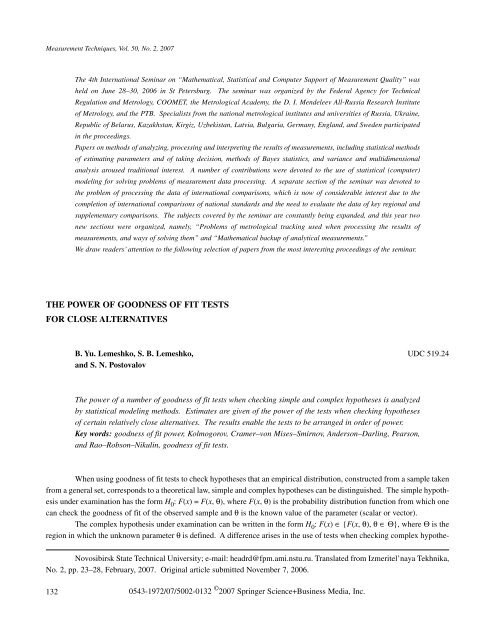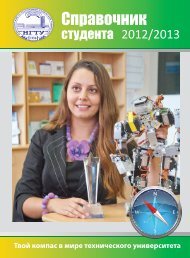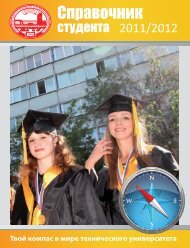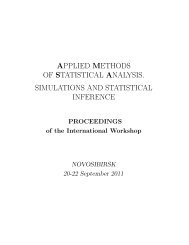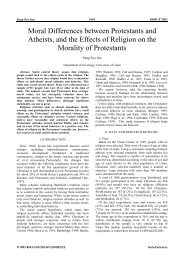The power of goodness of fit tests for close ... - ResearchGate
The power of goodness of fit tests for close ... - ResearchGate
The power of goodness of fit tests for close ... - ResearchGate
Create successful ePaper yourself
Turn your PDF publications into a flip-book with our unique Google optimized e-Paper software.
Measurement Techniques, Vol. 50, No. 2, 2007<br />
<strong>The</strong> 4th International Seminar on “Mathematical, Statistical and Computer Support <strong>of</strong> Measurement Quality” was<br />
held on June 28–30, 2006 in St Petersburg. <strong>The</strong> seminar was organized by the Federal Agency <strong>for</strong> Technical<br />
Regulation and Metrology, COOMET, the Metrological Academy, the D. I. Mendeleev All-Russia Research Institute<br />
<strong>of</strong> Metrology, and the PTB. Specialists from the national metrological institutes and universities <strong>of</strong> Russia, Ukraine,<br />
Republic <strong>of</strong> Belarus, Kazakhstan, Kirgiz, Uzbekistan, Latvia, Bulgaria, Germany, England, and Sweden participated<br />
in the proceedings.<br />
Papers on methods <strong>of</strong> analyzing, processing and interpreting the results <strong>of</strong> measurements, including statistical methods<br />
<strong>of</strong> estimating parameters and <strong>of</strong> taking decision, methods <strong>of</strong> Bayes statistics, and variance and multidimensional<br />
analysis aroused traditional interest. A number <strong>of</strong> contributions were devoted to the use <strong>of</strong> statistical (computer)<br />
modeling <strong>for</strong> solving problems <strong>of</strong> measurement data processing. A separate section <strong>of</strong> the seminar was devoted to<br />
the problem <strong>of</strong> processing the data <strong>of</strong> international comparisons, which is now <strong>of</strong> considerable interest due to the<br />
completion <strong>of</strong> international comparisons <strong>of</strong> national standards and the need to evaluate the data <strong>of</strong> key regional and<br />
supplementary comparisons. <strong>The</strong> subjects covered by the seminar are constantly being expanded, and this year two<br />
new sections were organized, namely, “Problems <strong>of</strong> metrological tracking used when processing the results <strong>of</strong><br />
measurements, and ways <strong>of</strong> solving them” and “Mathematical backup <strong>of</strong> analytical measurements.”<br />
We draw readers’ attention to the following selection <strong>of</strong> papers from the most interesting proceedings <strong>of</strong> the seminar.<br />
THE POWER OF GOODNESS OF FIT TESTS<br />
FOR CLOSE ALTERNATIVES<br />
B. Yu. Lemeshko, S. B. Lemeshko,<br />
and S. N. Postovalov<br />
UDC 519.24<br />
<strong>The</strong> <strong>power</strong> <strong>of</strong> a number <strong>of</strong> <strong>goodness</strong> <strong>of</strong> <strong>fit</strong> <strong>tests</strong> when checking simple and complex hypotheses is analyzed<br />
by statistical modeling methods. Estimates are given <strong>of</strong> the <strong>power</strong> <strong>of</strong> the <strong>tests</strong> when checking hypotheses<br />
<strong>of</strong> certain relatively <strong>close</strong> alternatives. <strong>The</strong> results enable the <strong>tests</strong> to be arranged in order <strong>of</strong> <strong>power</strong>.<br />
Key words: <strong>goodness</strong> <strong>of</strong> <strong>fit</strong> <strong>power</strong>, Kolmogorov, Cramer–von Mises–Smirnov, Anderson–Darling, Pearson,<br />
and Rao–Robson–Nikulin, <strong>goodness</strong> <strong>of</strong> <strong>fit</strong> <strong>tests</strong>.<br />
When using <strong>goodness</strong> <strong>of</strong> <strong>fit</strong> <strong>tests</strong> to check hypotheses that an empirical distribution, constructed from a sample taken<br />
from a general set, corresponds to a theoretical law, simple and complex hypotheses can be distinguished. <strong>The</strong> simple hypothesis<br />
under examination has the <strong>for</strong>m H 0 : F(x) = F(x, θ), where F(x, θ) is the probability distribution function from which one<br />
can check the <strong>goodness</strong> <strong>of</strong> <strong>fit</strong> <strong>of</strong> the observed sample and θ is the known value <strong>of</strong> the parameter (scalar or vector).<br />
<strong>The</strong> complex hypothesis under examination can be written in the <strong>for</strong>m H 0 : F(x) ∈ {F(x, θ), θ∈Θ}, where Θ is the<br />
region in which the unknown parameter θ is defined. A difference arises in the use <strong>of</strong> <strong>tests</strong> when checking complex hypothe-<br />
Novosibirsk State Technical University; e-mail: headrd@fpm.ami.nstu.ru. Translated from Izmeritel’naya Tekhnika,<br />
No. 2, pp. 23–28, February, 2007. Original article submitted November 7, 2006.<br />
132<br />
0543-1972/07/5002-0132 © 2007 Springer Science+Business Media, Inc.
ses and corresponding problems if the estimate <strong>of</strong> the parameter q <strong>of</strong> a theoretical distribution is calculated using the same<br />
sample with which the <strong>goodness</strong> <strong>of</strong> <strong>fit</strong> is verified. We will further assume that when checking complex hypotheses the estimate<br />
<strong>of</strong> the parameter q is calculated using the same sample.<br />
Two <strong>for</strong>ms <strong>of</strong> error arise from the checked statistical hypotheses: errors <strong>of</strong> the 1st kind consists <strong>of</strong> the fact that, as a<br />
result <strong>of</strong> checking, the true hypothesis H 0 deviates, while an error <strong>of</strong> the 2nd kind consists <strong>of</strong> recognizing the true hypothesis<br />
H 0 when a certain competing hypothesis H 1 is correct.<br />
<strong>The</strong> procedure <strong>for</strong> checking the hypothesis H 0 assumes that the distribution G(S⏐H 0 ) <strong>of</strong> the statistics S <strong>of</strong> the test<br />
employed is known when H 0 is correct. For <strong>goodness</strong> <strong>of</strong> <strong>fit</strong> <strong>tests</strong>, the critical regions are characterized by large values <strong>of</strong> the<br />
statistics. <strong>The</strong> probability α <strong>of</strong> an error <strong>of</strong> the 1st kind (the level <strong>of</strong> significance) is the probability that the value <strong>of</strong> the statistics<br />
will fall in the critical region α = P{S > S α ⏐H 0 } = 1 – G(S α ⏐H 0 ), where S α is the critical value. As a rule, the value <strong>of</strong><br />
α is given when checking hypotheses. If the value <strong>of</strong> the statistics calculated from the sample S * ≤ S α ,one does not deviate<br />
from the hypothesis H 0 under examination. A knowledge <strong>of</strong> the distribution G(S⏐H 0 ) enables one, from the value <strong>of</strong> S * ,to<br />
obtain P{S > S * ⏐H 0 } = 1 – G(S * ⏐H 0 ) – the level <strong>of</strong> significance reached. One does not deviate from the hypothesis H 0 under<br />
examination when P{S > S * ⏐H 0 } > α.<br />
If a competing hypothesis H 1 is specified, we define the probability <strong>of</strong> an error <strong>of</strong> the 2nd kind by the relation β =<br />
= P{S ≤ S α ⏐H 1 } = G(S α ⏐H 1 ), where G(S⏐H 1 ) is the distribution <strong>of</strong> the test statistics when H 1 holds. If the test is completely<br />
defined, the specification <strong>of</strong> α uniquely defines the value <strong>of</strong> β and conversely. <strong>The</strong> <strong>power</strong> <strong>of</strong> a test 1 – β when checking the<br />
hypothesis H 0 against H 1 is a function which depends on H 0 , H 1 , the volume <strong>of</strong> the sample n and, possibly, on certain other<br />
factors, connected with the construction <strong>of</strong> the test.<br />
When carrying out a statistical analysis <strong>of</strong> data, giving preference to a certain test, the experimentor wishes to have<br />
assurance that, <strong>for</strong> a certain probability <strong>of</strong> an error α <strong>of</strong> the 1st kind, one is guaranteed a minimum probability <strong>of</strong> an error β <strong>of</strong><br />
the 2nd kind, i.e., one can choose the test which is the most <strong>power</strong>ful <strong>of</strong> the pair <strong>of</strong> alternatives H 0 and H 1 <strong>of</strong> interest to him.<br />
<strong>The</strong> in<strong>for</strong>mation in various sources regarding the advantages in certain situations <strong>of</strong> one <strong>goodness</strong> <strong>of</strong> <strong>fit</strong> test or another<br />
is not unique, <strong>of</strong>ten contradictory, and subjective. Investigations <strong>of</strong> the <strong>power</strong> are made difficult by the lack <strong>of</strong> results connected<br />
with the analytical representation <strong>of</strong> the distribution functions G(S⏐H 1 ) <strong>for</strong> specific <strong>goodness</strong> <strong>of</strong> <strong>fit</strong> <strong>tests</strong> when checking<br />
complex hypotheses, in particular, <strong>for</strong> nonparametric <strong>tests</strong> and <strong>for</strong> χ 2 -type teests when estimating parameters from point<br />
samples (from ungrouped observations).<br />
<strong>The</strong> purpose <strong>of</strong> these investigations is to carry out a comparative analysis <strong>of</strong> the <strong>power</strong> <strong>of</strong> the <strong>goodness</strong> <strong>of</strong> <strong>fit</strong> <strong>tests</strong><br />
most <strong>of</strong>ten used on certain pairs <strong>of</strong> fairly <strong>close</strong> competing hypotheses H 0 and H 1 .<br />
In the Kolmogorov test [1] statistics with a correction, proposed in [2], <strong>of</strong> the <strong>for</strong>m<br />
are most <strong>of</strong>ten used, where<br />
6nDn<br />
+ 1<br />
Sk<br />
= ,<br />
6 n<br />
+ − +<br />
−<br />
Dn = max( Dn , Dn ); Dn<br />
= max{ i/ n− F( xi, θ)}; Dn<br />
= max{ F( xi, θ) −( i−1) / n};<br />
1≤≤<br />
i n<br />
1≤≤<br />
i n<br />
n is the volume <strong>of</strong> the sample; and x 1 , x 2 ,…,x n are sample values in increasing order. For the simple hypothesis under examination<br />
to be correct, the statistics S k in the limit must obey the Kolmogorov distribution law K(s) [1].<br />
<strong>The</strong> Cramer–von Mises–Smirnov ω 2 test statistics have the <strong>for</strong>m [1]:<br />
n<br />
2<br />
2 1 ⎧⎪<br />
2i<br />
− 1⎫⎪<br />
Sω = nωn<br />
= + ⎨Fxi<br />
θ − ⎬<br />
n<br />
∑ ( , ) .<br />
12<br />
n<br />
i=<br />
1 ⎩⎪ 2 ⎭<br />
When the simple hypothesis holds, the statistics in the limit must obey a law with the distribution function a1(s) [1].<br />
133
<strong>The</strong> Anderson–Darling Ω test statistics is given by the expression [1]<br />
n<br />
⎧⎪<br />
i −<br />
⎛ i − ⎞<br />
⎫<br />
2<br />
2 1<br />
2 1<br />
⎪<br />
SΩ<br />
= nΩ n = −n−2∑<br />
⎨ ln Fx ( i, θ) + −<br />
Fxi<br />
n<br />
⎜1<br />
⎝ n<br />
⎟ ln ( 1 − ( , θ)) ⎬,<br />
⎠<br />
i=<br />
1 ⎩⎪ 2<br />
2<br />
⎭⎪<br />
and when the simple hypothesis holds in the limit it must obey a law with distribution function a2(s) [1].<br />
When checking simple hypotheses, the limit distributions <strong>of</strong> the statistics <strong>of</strong> these nonparametric <strong>tests</strong> are independent<br />
<strong>of</strong> the <strong>for</strong>m <strong>of</strong> the distribution law observed. <strong>The</strong>y are there<strong>for</strong>e said to be distribution-free.<br />
When checking complex hypotheses, when the parameters <strong>of</strong> the law are estimated from the same sample, nonparametric<br />
<strong>tests</strong> lose the “distribution-free” property [3]. Moreover, the distributions <strong>of</strong> the test statistics become dependent<br />
on the <strong>for</strong>m <strong>of</strong> the complex hypothesis under examination [4].<br />
<strong>The</strong> analytical <strong>for</strong>m <strong>of</strong> the (limit) distributions <strong>of</strong> the statistics G(S⏐H 0 ) <strong>of</strong> nonparametric <strong>tests</strong> when checking complex<br />
hypotheses is unknown. <strong>The</strong>re are particular solutions in which different approaches are employed. Obviously, the most<br />
promising one <strong>for</strong> constructing the distributions <strong>of</strong> the statistics is a numerical approach, based on statistical modeling <strong>of</strong><br />
empirical distributions <strong>of</strong> the statistics and the construction <strong>for</strong> them <strong>of</strong> approximate analytical models [4–8].<br />
<strong>The</strong> use <strong>of</strong> the Pearson χ 2 test requires the region in which the random quantity is defined to be split into k intervals<br />
and the calculation <strong>of</strong> the number <strong>of</strong> observations n i which fall within them, and the probabilities <strong>of</strong> them falling in the interval<br />
P i (θ) corresponding to the theoretical law. <strong>The</strong> statistics <strong>of</strong> the test have the <strong>for</strong>m<br />
2<br />
Xn<br />
k<br />
2<br />
ni<br />
n−<br />
Pi<br />
= n∑ ( / ( θ )) .<br />
P<br />
i=<br />
1 i( θ)<br />
(1)<br />
When checking a simple valid hypothesis in the limit, the statistics obey a χ 2 k–1-distribution with k = 1 degrees <strong>of</strong><br />
freedom.<br />
When checking a complex hypothesis when H 0 holds and under conditions that the estimates <strong>of</strong> the parameters are<br />
2<br />
found as a result <strong>of</strong> minimizing the statistics (1) using the same sample, the statistics X n is asymptotically distributed as<br />
χ 2 k–r–1 ,where r is the number <strong>of</strong> parameters estimated from the sample. <strong>The</strong> statistics (1) have the same distribution if we<br />
choose the maximum-likelihood method as the method <strong>of</strong> estimation and the estimates are calculated from classified data [9].<br />
It has been shown by statistical modeling that this also occurs when using other asymptotically effective estimates based on<br />
classified data [10].<br />
When calculating maximum-likelihood estimates using unclassified data, the same statistics is subject to a law<br />
which differs from the χk–r–1 2 -distribution. In this case, when checking complex hypotheses and using the maximum likelihood<br />
estimates based on unclassified observations <strong>of</strong> the distribution G(X n⏐H0 ), the statistics <strong>of</strong> the test depend considerably<br />
2<br />
on the method <strong>of</strong> classification [11].<br />
When preparing methods <strong>of</strong> statistical modeling, investigations were carried out on the distribution laws <strong>of</strong> χ 2 -type<br />
statistics in the case <strong>of</strong> simple and different complex hypotheses, when the hypothesis H 0 holds together with a competing<br />
hypothesis H 1 ,<strong>for</strong> equiprobable and asymptotically optimum classification [12]. In the asymptotically optimum classification,<br />
the losses in the Fisher in<strong>for</strong>mation are minimized, connected with the classification, and the <strong>power</strong> <strong>of</strong> the Pearson χ 2 test is<br />
maximized with respect to the nearest competing hypotheses.<br />
When checking complex hypotheses employing χ 2 -type <strong>tests</strong>, the use <strong>of</strong> estimates based on unclassified (point) observations<br />
has definite advantages, since these estimates have the best asymptotic properties compared with estimates based on classified<br />
data. Tests based on the Rao–Robson–Nikulin statistics [13] belong to <strong>tests</strong> <strong>of</strong> this kind. It is noteworthy that the statistics<br />
<strong>of</strong> these <strong>tests</strong> when H 0 holds in the limit obey a χ 2 k–1-distribution irrespective <strong>of</strong> the number <strong>of</strong> parameters <strong>of</strong> the law, estimated<br />
by the maximum-likelihood method, while the <strong>power</strong> <strong>of</strong> the test, as a rule, is greater than the <strong>power</strong> <strong>of</strong> the Pearson χ 2 test.<br />
In this case, the statistics proposed by Nikulin [14–16] were considered. <strong>The</strong> test specifies the estimation <strong>of</strong> the<br />
unknown parameters <strong>of</strong> the distribution F(x, θ) by the maximum-likelihood method using unclassified data. In this case, the<br />
134
vector <strong>of</strong> the probabilities <strong>of</strong> falling in the intervals P = (P 1 , ..., P k ) T is assumed to be given, and the boundary points <strong>of</strong> the<br />
intervals are found from the relations<br />
<strong>The</strong> proposed statistics have the <strong>for</strong>m [14]:<br />
where X n<br />
2 are calculated from (1); the matrix<br />
−1<br />
xi( θ ) = F ( P1 + ... + Pi), i = 1, ( k −1).<br />
2 2 1<br />
Yn<br />
= Xn<br />
+ n − a T ( θ) Λ( θ) a( θ),<br />
−1<br />
k wθ<br />
w<br />
li<br />
θ ji<br />
Λ( θ) = J( θl, θj) −∑<br />
,<br />
p<br />
i=<br />
1 i<br />
the elements and dimensions <strong>of</strong> which are determined by the estimated components <strong>of</strong> the vector <strong>of</strong> the parameters θ;<br />
J( θl, θj)<br />
=<br />
∫<br />
⎛ ∂f( x, θ) ∂f( x, θ)<br />
⎞<br />
⎜<br />
⎝ ∂θl<br />
∂θ<br />
⎟<br />
j ⎠<br />
f( x, θ)<br />
dx<br />
are the elements <strong>of</strong> the in<strong>for</strong>mation matrix based on unclassified data, the components <strong>of</strong> the vector a(θ) have the <strong>for</strong>m<br />
a θ = w n P w n P<br />
l θ l1 1/ 1+ ... + θ l k k / k<br />
and<br />
∂x<br />
w f x<br />
l i i i( θ)<br />
θ =− [ ( θ), θ]<br />
+<br />
∂θl<br />
∂xi−1( θ) f[ xi−1( θ), θ]<br />
.<br />
∂θl<br />
N<br />
When estimating the values <strong>of</strong> the <strong>power</strong> <strong>of</strong> the <strong>tests</strong> in order to construct empirical distributions G n (S⏐H0 ) and<br />
N<br />
G n (S⏐H1 ) <strong>of</strong> the corresponding statistics S, it is most convenient to use statistical modeling methods. To do this, one models<br />
samples <strong>of</strong> the statistics S 1 , S 2 , ..., S N <strong>of</strong> a fairly large volume N <strong>for</strong> specific volumes <strong>of</strong> samples n <strong>of</strong> the observed quantities,<br />
modeled using laws corresponding to the hypothesis under examination H 0 and the competing hypothesis H 1 . Further,<br />
as a rule, N = 10 6 while the index N in the notation <strong>of</strong> the corresponding empirical functions is omitted.<br />
We will illustrate the results <strong>of</strong> a comparative analysis <strong>of</strong> the <strong>power</strong> <strong>of</strong> the <strong>goodness</strong> <strong>of</strong> <strong>fit</strong> <strong>tests</strong> by two pairs <strong>of</strong> alternatives.<br />
<strong>The</strong> normal and logistical laws comprise the first pair: the hypothesis H 0 under examination corresponded to a normal<br />
law with density<br />
1<br />
⎧<br />
⎪ ( x − θ ) ⎫<br />
1 2 ⎪<br />
f( x) = exp ⎨−<br />
⎬,<br />
2<br />
θ0<br />
2π<br />
⎩⎪ 2θ0<br />
⎭⎪<br />
while the competing hypothesis H 1 corresponded to a logistical law with density function<br />
π ⎪ ( x )<br />
f( x) = exp<br />
⎧− ⎨<br />
π − θ ⎫<br />
1 ⎪<br />
⎬<br />
θ0<br />
3 ⎩⎪ θ0<br />
3 ⎭⎪<br />
2<br />
⎡ ⎧<br />
⎪ ( x )<br />
+ exp ⎨− π − ⎫<br />
⎢<br />
θ<br />
⎤<br />
1 ⎪<br />
1<br />
⎬⎥<br />
⎢<br />
⎥<br />
⎣ ⎩⎪ θ0<br />
3 ⎭⎪<br />
⎦<br />
and the parameters θ 0 = 1 and θ 1 = 0. In the case <strong>of</strong> the simple hypothesis H 0 , the parameters <strong>of</strong> the normal law have the<br />
same values. Since these two laws are very <strong>close</strong>, it is difficult to distinguish them using <strong>goodness</strong> <strong>of</strong> <strong>fit</strong> <strong>tests</strong>.<br />
135
TABLE 1. Power <strong>of</strong> the Goodness <strong>of</strong> Fit Tests When Checking a Simple Hypothesis H 0 (a normal<br />
distribution) Against an Alternative H 1 (logistical)<br />
Significance<br />
Value <strong>of</strong> the <strong>power</strong> <strong>for</strong> n<br />
level α 100 200 300 500 1000 2000<br />
Pearson χ 2 test <strong>for</strong> k = 15 and asymptotically optimal classification<br />
0.15 0.349 0.459 0.565 0.737 0.946 0.999<br />
0.1 0.290 0.388 0.490 0.671 0.922 0.998<br />
0.05 0.210 0.292 0.385 0.565 0.871 0.996<br />
0.025 0.154 0.222 0.302 0.472 0.813 0.992<br />
0.01 0.107 0.159 0.221 0.369 0.729 0.983<br />
Anderson–Darling Ω 2 test<br />
0.15 0.194 0.258 0.328 0.472 0.776 0.982<br />
0.1 0.125 0.169 0.222 0.343 0.654 0.957<br />
0.05 0.057 0.079 0.107 0.181 0.439 0.869<br />
0.025 0.026 0.036 0.049 0.088 0.261 0.724<br />
0.01 0.010 0.013 0.017 0.031 0.114 0.491<br />
Kolmogorov test<br />
0.15 0.190 0.246 0.303 0.415 0.662 0.922<br />
0.1 0.127 0.170 0.215 0.309 0.544 0.861<br />
0.05 0.062 0.088 0.116 0.179 0.365 0.721<br />
0.025 0.031 0.044 0.061 0.100 0.231 0.560<br />
0.01 0.012 0.018 0.026 0.044 0.119 0.366<br />
Cramer–von Mises–Smirnov ω 2 test<br />
0.15 0.178 0.228 0.283 0.401 0.680 0.947<br />
0.1 0.114 0.147 0.186 0.277 0.542 0.892<br />
0.05 0.052 0.067 0.086 0.136 0.324 0.742<br />
0.025 0.024 0.030 0.039 0.062 0.171 0.548<br />
0.01 0.010 0.011 0.014 0.021 0.065 0.307<br />
<strong>The</strong> second pair was as follows: H 0 is a Weibull distribution with density<br />
θ<br />
θ0( x − θ1)<br />
f( x)<br />
=<br />
θ0<br />
θ1<br />
−1<br />
⎧<br />
θ<br />
⎛ ( x − ) ⎞<br />
0 ⎫<br />
⎪ θ2<br />
⎪<br />
exp ⎨−⎜<br />
⎟ ⎬<br />
⎪ ⎝ θ1<br />
⎠<br />
⎩<br />
⎭<br />
⎪<br />
and parameters θ 0 = 2, θ 1 = 2, and θ 2 = 0; H 1 is a gamma distribution with density<br />
0<br />
θ<br />
⎛ x − ⎞<br />
0 −1<br />
1 θ2<br />
f( x)<br />
=<br />
exp[ ( x ) / ]<br />
( )<br />
⎜ ⎟ − −θ2 θ1<br />
θ1Γ<br />
θ0<br />
⎝ θ1<br />
⎠<br />
and parameters θ 0 = 3.12154, θ 1 = 0.557706, and θ 2 = 0, <strong>for</strong> which the gamma distribution is <strong>close</strong>st to this Weibull distribution.<br />
We investigated the <strong>power</strong> when checking simple and complex hypotheses H 0 against the simple alternative H 1 .<br />
We used the maximum-likelihood method when checking complex hypotheses in the case <strong>of</strong> all the <strong>goodness</strong> <strong>of</strong> <strong>fit</strong><br />
<strong>tests</strong> investigated in order to estimate the unknown parameters. Here all the <strong>tests</strong> were under equal conditions. Moreover,<br />
136
TABLE 2. Power <strong>of</strong> the Goodness <strong>of</strong> Fit Tests When Checking a Complex Hypothesis H 0 (a normal distribution) Against an<br />
Alternative H 1 (logistical)<br />
Significance<br />
Value <strong>of</strong> the <strong>power</strong> <strong>for</strong> n<br />
level α 20 50 100 200 300 500 1000 2000<br />
Anderson–Darling Ω 2 test<br />
0.15 0.222 0.297 0.400 0.575 0.708 0.873 0.989 1.000<br />
0.1 0.164 0.230 0.324 0.496 0.636 0.828 0.981 1.000<br />
0.05 0.098 0.149 0.224 0.377 0.519 0.741 0.963 1.000<br />
0.025 0.060 0.096 0.152 0.282 0.414 0.649 0.935 0.999<br />
0.01 0.031 0.054 0.091 0.186 0.297 0.525 0.885 0.998<br />
2<br />
Nikulin Y n test <strong>for</strong> k = 15 and asymptotically optimum classification<br />
0.15 0.245 0.320 0.395 0.536 0.646 0.806 0.967 1.000<br />
0.1 0.195 0.249 0.332 0.466 0.579 0.755 0.952 0.999<br />
0.05 0.137 0.165 0.248 0.368 0.480 0.669 0.921 0.998<br />
0.025 0.077 0.112 0.184 0.291 0.395 0.587 0.883 0.996<br />
0.01 0.036 0.071 0.125 0.213 0.304 0.488 0.825 0.992<br />
Cramer–von Mises–Smirnov ω 2 test<br />
0.15 0.210 0.273 0.366 0.529 0.659 0.836 0.980 1.000<br />
0.1 0.153 0.208 0.291 0.447 0.582 0.781 0.968 1.000<br />
0.05 0.090 0.130 0.194 0.329 0.458 0.678 0.939 0.999<br />
0.025 0.053 0.082 0.128 0.237 0.353 0.573 0.897 0.998<br />
0.01 0.027 0.044 0.074 0.150 0.243 0.445 0.825 0.994<br />
Pearson χ 2 test <strong>for</strong> k = 15 and asymptotically optimal classification<br />
0.15 0.243 0.295 0.342 0.467 0.579 0.751 0.950 0.999<br />
0.1 0.194 0.220 0.280 0.393 0.502 0.688 0.928 0.998<br />
0.05 0.140 0.133 0.199 0.291 0.391 0.583 0.882 0.996<br />
0.025 0.081 0.080 0.137 0.214 0.303 0.486 0.827 0.992<br />
0.01 0.036 0.043 0.079 0.139 0.213 0.376 0.745 0.984<br />
Kolmogorov test<br />
0.15 0.200 0.246 0.313 0.440 0.554 0.732 0.941 0.999<br />
0.1 0.142 0.181 0.236 0.351 0.459 0.646 0.905 0.997<br />
0.05 0.080 0.105 0.143 0.230 0.322 0.502 0.823 0.990<br />
0.025 0.045 0.061 0.086 0.149 0.219 0.376 0.721 0.975<br />
0.01 0.021 0.029 0.043 0.081 0.127 0.244 0.575 0.938<br />
TABLE 3. Power <strong>of</strong> the Test <strong>for</strong> Checking the Deviation <strong>of</strong> a Distribution from a Normal Law<br />
Against an Alternative H 1 (a logistical law)<br />
Significance<br />
Value <strong>of</strong> the <strong>power</strong> <strong>of</strong> the test <strong>for</strong> n = 20 and 50<br />
level Shapiro–Wilk Epps–Pally D’Agostino with z 2<br />
α<br />
20 50 20 50 20 50<br />
0.1 0.181 0.202 0.178 0.249 0.189 0.327<br />
0.05 0.117 0.141 0.111 0.165 0.111 0.223<br />
0.01 0.044 0.067 0.037 0.062 0.032 0.089<br />
137
TABLE 4. Power <strong>of</strong> the Goodness <strong>of</strong> Fit Tests <strong>for</strong> Checking a Simple Hypothesis H 0 (a Weibull<br />
distribution) Against an Alternative H 1 (a gamma distribution)<br />
Significance<br />
Value <strong>of</strong> the <strong>power</strong> <strong>for</strong> n<br />
level α 100 200 300 500 1000 2000<br />
Pearson χ 2 test <strong>for</strong> k = 15 and the asymptotically optimum classification<br />
0.15 0.486 0.621 0.757 0.909 0.996 1.000<br />
0.1 0.418 0.556 0.701 0.876 0.993 1.000<br />
0.05 0.324 0.469 0.611 0.815 0.986 1.000<br />
0.025 0.254 0.403 0.529 0.751 0.974 1.000<br />
0.01 0.191 0.332 0.437 0.668 0.954 1.000<br />
Anderson–Darling Ω 2 test<br />
0.15 0.302 0.446 0.577 0.781 0.976 1.000<br />
0.1 0.223 0.348 0.473 0.689 0.951 1.000<br />
0.05 0.131 0.224 0.326 0.533 0.882 0.998<br />
0.025 0.076 0.141 0.220 0.396 0.785 0.993<br />
0.01 0.037 0.075 0.126 0.257 0.636 0.975<br />
Cramer–von Mises–Smirnov ω 2 test<br />
0.15 0.295 0.425 0.539 0.716 0.931 0.998<br />
0.1 0.224 0.343 0.453 0.637 0.894 0.995<br />
0.05 0.138 0.233 0.329 0.508 0.816 0.987<br />
0.025 0.084 0.155 0.233 0.393 0.725 0.970<br />
0.01 0.043 0.088 0.142 0.270 0.597 0.934<br />
Kolmogorov test<br />
0.15 0.294 0.421 0.531 0.700 0.915 0.995<br />
0.1 0.225 0.342 0.450 0.628 0.879 0.992<br />
0.05 0.141 0.237 0.332 0.508 0.806 0.981<br />
0.025 0.087 0.160 0.239 0.401 0.723 0.964<br />
0.01 0.045 0.093 0.150 0.282 0.606 0.930<br />
the Kolmogorov, Cramer–von Mises–Smirnov ω 2 , and Anderson–Darling Ω 2 type nonparametric <strong>tests</strong> are the most <strong>power</strong>ful<br />
compared with the case when the estimates are found by minimizing the corresponding statistics [6].<br />
In Table 1, we show estimates <strong>of</strong> the <strong>power</strong> <strong>of</strong> the <strong>goodness</strong> <strong>of</strong> <strong>fit</strong> <strong>tests</strong> considered, calculated from the results <strong>of</strong><br />
modeling distributions <strong>of</strong> the statistics, in the case <strong>of</strong> a pair <strong>of</strong> normal–logistical alternatives <strong>for</strong> different values <strong>of</strong> the significance<br />
level α when checking a simple hypothesis H 0 , corresponding to a normal law with parameters (0, 1), against an<br />
alternative H 1 , corresponding to a logistical law with the same set <strong>of</strong> parameters. <strong>The</strong> error <strong>of</strong> the estimates <strong>of</strong> the <strong>power</strong><br />
when checking the simple hypotheses and a 95% confidence interval does not exceed ±10 –3 . <strong>The</strong> <strong>tests</strong> are arranged in order<br />
<strong>of</strong> decreasing <strong>power</strong>.<br />
In Table 1, we show the maximum <strong>power</strong> <strong>of</strong> the Pearson χ 2 test, which it has <strong>for</strong> a given pair <strong>of</strong> alternatives <strong>for</strong> k =15<br />
and asymptotically optimum classification. For equiprobable classification, the Pearson χ 2 test against a given pair <strong>of</strong> alternatives<br />
has maximum <strong>power</strong> <strong>for</strong> k = 4 [17]. Further, the <strong>power</strong> falls <strong>of</strong>f as k increases. But this maximum level <strong>of</strong> <strong>power</strong> is<br />
less than the <strong>power</strong> <strong>of</strong> the given test when k = 9 and using the asymptotically optimum classification.<br />
Estimates <strong>of</strong> the <strong>power</strong> when checking a complex hypothesis H 0 , corresponding to the observed sample having a<br />
normal law against the same simple competing hypothesis H 1 ,are shown in Table 2. Here also the criteria are arranged in<br />
order <strong>of</strong> decreasing <strong>power</strong>. It should be noted that in certain cases the preference is not obvious since, although possessing<br />
138
TABLE 5. Power <strong>of</strong> the Goodness <strong>of</strong> Fit Tests When Checking a Complex Hypothesis H 0 (a Weibull<br />
distribution) Against an Alternative H 1 (a gamma distribution)<br />
Significance<br />
Value <strong>of</strong> the <strong>power</strong> <strong>for</strong> n<br />
level α 100 200 300 500 1000 2000<br />
Anderson–Darling Ω 2 test<br />
0.15 0.435 0.667 0.817 0.952 0.999 1.000<br />
0.1 0.353 0.589 0.757 0.928 0.998 1.000<br />
0.05 0.244 0.466 0.650 0.876 0.995 1.000<br />
0.025 0.167 0.361 0.547 0.811 0.990 1.000<br />
0.01 0.100 0.252 0.424 0.715 0.977 1.000<br />
Cramer–von Mises–Smirnov ω 2 test<br />
0.15 0.396 0.603 0.750 0.913 0.996 1.000<br />
0.1 0.316 0.520 0.679 0.875 0.993 1.000<br />
0.05 0.212 0.394 0.560 0.797 0.984 1.000<br />
0.025 0.143 0.295 0.452 0.712 0.968 1.000<br />
0.01 0.082 0.196 0.330 0.593 0.936 1.000<br />
Nikulin Y 2 n test <strong>for</strong> k = 9 and asymptotically optimum classification<br />
0.15 0.324 0.511 0.665 0.869 0.993 1.000<br />
0.1 0.246 0.423 0.584 0.818 0.987 1.000<br />
0.05 0.153 0.299 0.454 0.720 0.973 1.000<br />
0.025 0.096 0.209 0.347 0.619 0.951 1.000<br />
0.01 0.051 0.129 0.238 0.492 0.909 0.999<br />
Pearson χ 2 test <strong>for</strong> k = 9 and asymptotically optimum classification<br />
0.15 0.347 0.525 0.678 0.868 0.992 1.000<br />
0.1 0.273 0.439 0.596 0.818 0.986 1.000<br />
0.05 0.172 0.311 0.463 0.719 0.970 1.000<br />
0.025 0.104 0.218 0.352 0.617 0.946 1.000<br />
0.01 0.053 0.133 0.237 0.483 0.898 0.999<br />
Kolmogorov test<br />
0.15 0.340 0.510 0.646 0.830 0.981 1.000<br />
0.1 0.262 0.420 0.558 0.762 0.965 1.000<br />
0.05 0.164 0.293 0.420 0.640 0.925 0.999<br />
0.025 0.101 0.200 0.306 0.519 0.867 0.997<br />
0.01 0.052 0.115 0.193 0.375 0.763 0.988<br />
a higher <strong>power</strong> <strong>for</strong> some levels <strong>of</strong> significance and some sample volumes, the test may lose out <strong>for</strong> other values <strong>of</strong> α and n.<br />
In Table 2, the maximum <strong>power</strong> <strong>of</strong> the Nikulin and Pearson χ 2 <strong>tests</strong> is shown.<br />
When estimating the <strong>power</strong> when checking complex hypotheses, we based ourselves on modeled distributions <strong>of</strong> the<br />
statistics G(S⏐H 0 ) <strong>for</strong> a sample volume n = 1000. With such large values <strong>of</strong> n, the empirical distribution <strong>of</strong> the statistics can<br />
be assumed to be a good estimate <strong>of</strong> the limit law.<br />
When checking complex hypotheses and sample volumes n = 20 and 50 <strong>for</strong> all the <strong>tests</strong> investigated, the distributions<br />
G(S 20 ⏐H 0 ) and G(S 50 ⏐H 0 ) differ considerably from the “limit” distribution G(S n ⏐H 0 ) <strong>for</strong> n = 1000. Hence the <strong>power</strong><br />
was estimated from modeled pairs <strong>of</strong> distributions <strong>of</strong> the <strong>for</strong>m G(S 20 ⏐H 0 ), G(S 20 ⏐H 1 ) and G(S 50 ⏐H 0 ), G(S 50 ⏐H 1 ).<br />
139
<strong>The</strong> <strong>power</strong> <strong>of</strong> the <strong>goodness</strong> <strong>of</strong> <strong>fit</strong> <strong>tests</strong> <strong>for</strong> small sample volumes n can be compared with the <strong>power</strong> <strong>of</strong> <strong>tests</strong> constructed<br />
specially to check the deviation <strong>of</strong> a distribution from a normal law: using the Shapiro–Wilk, Epps–Pally, and<br />
D’Agostino <strong>tests</strong> with statistics z 2 . Estimates <strong>of</strong> the <strong>power</strong> <strong>of</strong> these <strong>tests</strong> <strong>of</strong> normality, obtained in [18] and improved in the<br />
present paper <strong>for</strong> volumes <strong>of</strong> the modeled samples <strong>of</strong> the statistics N = 10 6 ,are shown in Table 3, from which it follows that<br />
the “special” <strong>tests</strong> against the pair <strong>of</strong> alternatives considered turn out to be <strong>of</strong> somewhat greater <strong>power</strong> on average.<br />
<strong>The</strong> calculated estimates <strong>of</strong> the <strong>power</strong> <strong>of</strong> the <strong>tests</strong> <strong>for</strong> different values <strong>of</strong> the level <strong>of</strong> significance α when checking<br />
the <strong>goodness</strong> <strong>of</strong> <strong>fit</strong> with the Weibull distribution (hypothesis H 0 ) against an alternative, corresponding to the gamma-distribution<br />
with these parameters (hypothesis H 1 ) <strong>for</strong> the simple hypothesis H 0 are shown in Table 4, and a complex hypothesis<br />
H 0 in Table 5. <strong>The</strong> <strong>tests</strong> in these tables are listed in order <strong>of</strong> decreasing <strong>power</strong>.<br />
Hence, <strong>for</strong> the case when checking simple hypotheses, the <strong>tests</strong> can be listed in order <strong>of</strong> <strong>power</strong> as follows:<br />
Pearson (asymptotically optimum classification) χ 2 P Anderson–Darling Ω 2 P von Mises ω 2 P= Kolmogorov.<br />
This scale holds when using the Pearson (asymptotically optimal classification) χ 2 in the test, <strong>for</strong> which the losses<br />
in Fisher in<strong>for</strong>mation are minimized. For very <strong>close</strong> hypotheses, we may have<br />
Kolmogorov P von Mises ω 2 .<br />
When checking complex hypotheses, the <strong>power</strong> gradation turns out to be quite different:<br />
Anderson–Darling Ω 2 P von Mises ω 2 P Y n<br />
2 (asymptotically optimum classification) P<br />
P Pearson (asymptotically optimum classification) X n<br />
2 P Kolmogorov.<br />
For very <strong>close</strong> hypotheses, we may have<br />
Anderson–Darling Ω 2 P Y n<br />
2 (asymptotically optimum classification) P von Mises ω<br />
2 P<br />
P Pearson (asymptotically optimum classification) χ 2 P Kolmogorov.<br />
<strong>The</strong>se conclusions have an integrated <strong>for</strong>m. <strong>The</strong> ordering is not rigid. As can be seen from the tables with listed<br />
values <strong>of</strong> the <strong>power</strong>, sometimes a test has advantages in <strong>power</strong> <strong>for</strong> some values <strong>of</strong> α and sample volumes n but is inferior <strong>for</strong><br />
other values <strong>of</strong> α and n.<br />
It should be borne in mind that the <strong>power</strong> <strong>of</strong> the Pearson and Nikulin χ 2 type <strong>tests</strong> depends not only on the hypotheses<br />
H 0 and H 1 and the sample volume n,but, <strong>for</strong> specified H 0 and H 1 , on the method <strong>of</strong> classification and the number <strong>of</strong> intervals.<br />
<strong>The</strong> number <strong>of</strong> intervals <strong>for</strong> which the <strong>power</strong> <strong>of</strong> the <strong>tests</strong> <strong>for</strong> a pair <strong>of</strong> alternatives H 0 and H 1 is a maximum depends on<br />
these hypotheses and on the method <strong>of</strong> classification. An increase in the number <strong>of</strong> intervals does not always lead to an<br />
increase in the <strong>power</strong> <strong>of</strong> χ 2 type <strong>tests</strong> [17].<br />
For <strong>close</strong> hypotheses H 0 and H 1 , the choice <strong>of</strong> asymptotically optimum classifications when using the Pearson χ 2<br />
test gives a positive effect <strong>for</strong> simple and complex hypotheses. However, this does not mean that the use <strong>of</strong> asymptotically<br />
optimum classifications always guarantees maximum <strong>power</strong> <strong>of</strong> the test. For specific and not very <strong>close</strong> hypotheses, certain<br />
other methods <strong>of</strong> classification may turn out to be optimum, which can be obtained as a result <strong>of</strong> maximizing the test <strong>power</strong>.<br />
For one and the same pair <strong>of</strong> hypotheses H 0 and H 1 <strong>for</strong> one number <strong>of</strong> intervals k, the Nikulin test may turn out to<br />
have a greater <strong>power</strong> with the asymptotically optimum classification, while <strong>for</strong> a different k it may be more <strong>power</strong>ful <strong>for</strong> an<br />
equiprobable classification. <strong>The</strong> dependence <strong>of</strong> the <strong>power</strong> <strong>of</strong> a given test on the method <strong>of</strong> classification turns out to be more<br />
complex and requires further investigation.<br />
This research was supported by the Ministry <strong>of</strong> Education and Science <strong>of</strong> the Russian Federation (project No. 2006-<br />
RI-19.0/001/119) and the Russian Fund <strong>for</strong> Basic Research (project No. 06-01-00059-a).<br />
140
REFERENCES<br />
1. L. N. Bol’shev and N. V. Smirnov, Tables <strong>of</strong> Mathematical Statistics [in Russian], Nauka, Moscow (1983).<br />
2. L. N. Bol’shev, Teor. Veroyat. Primenen., 8, No. 2, 129 (1963).<br />
3. M. Kac, J. Kiefer, and J. Wolfowitz, Ann. Math. Stat., 26, 189 (1955).<br />
4. R 50.1.037-2002, Recommendations on Standardization. Applied Statistics. Rules <strong>for</strong> Checking the Goodness <strong>of</strong> Fit<br />
<strong>of</strong> an Experimental Distribution with <strong>The</strong>oretical Ones. Pt. II. Nonparametric Test [in Russian], Izd. Standartov,<br />
Moscow (2002).<br />
5. B. Yu. Lemeshko and S. N. Postovalov, Zavod. Lab., 64, No. 3, 61 (1998).<br />
6. B. Yu. Lemeshko and S. N. Postovalov, Zavod. Lab., 67, No. 7, 62 (2001).<br />
7. B. Yu. Lemeshko and S. N. Postovalov, Avtometr., No. 2, 88 (2001).<br />
8. B. Yu. Lemeshko and A. A. Maklakov, Avtometr., No. 3, 3 (2004).<br />
9. G. Cramer, Mathematical Methods <strong>of</strong> Statistics [Russian translation], Mir, Moscow (1975).<br />
10. B. Yu. Lemeshko and E. V. Chimitova, Zavod. Lab. Diagnostika, Materialov, 70, No. 1, 54 (2004).<br />
11. R 50.1.033-2001, Recommendations on Standardization. Applied Statistics. Rules <strong>for</strong> Checking the Goodness <strong>of</strong> Fit<br />
<strong>of</strong> an Experimental Distribution with <strong>The</strong>oretical Ones. Pt. I. Chi-Squared Type Tests [in Russian], Izd. Standartov,<br />
Moscow (2002).<br />
12. B. Yu. Lemeshko, Zavod. Lab., 64, No. 1, 56 (1998).<br />
13. A. W. Van der Vaart, Asymptotic Statistics, University Press, Cambridge (1998).<br />
14. M. S. Nikulin, Teor. Veroyat. Primeneniya, XVIII, No. 3, 675 (1973).<br />
15. M. Mirvaliev and M. S. Nikulin, Zavod. Lab., 58 No. 3, 52 (1992).<br />
16. P. E. Greenwood and M. S. Nikulin, A Guide to Chi-Squared Testing, John Wiley, New York (1996).<br />
17. B. Yu. Lemeshko and E. V. Chimitova, Zavod. Lab. Diagnostika Materialov, 69, No. 1, 61 (2003).<br />
18. B. Yu. Lemeshko and S. B. Lemeshko, Metrologiya, No. 2, 3 (2005).<br />
141


